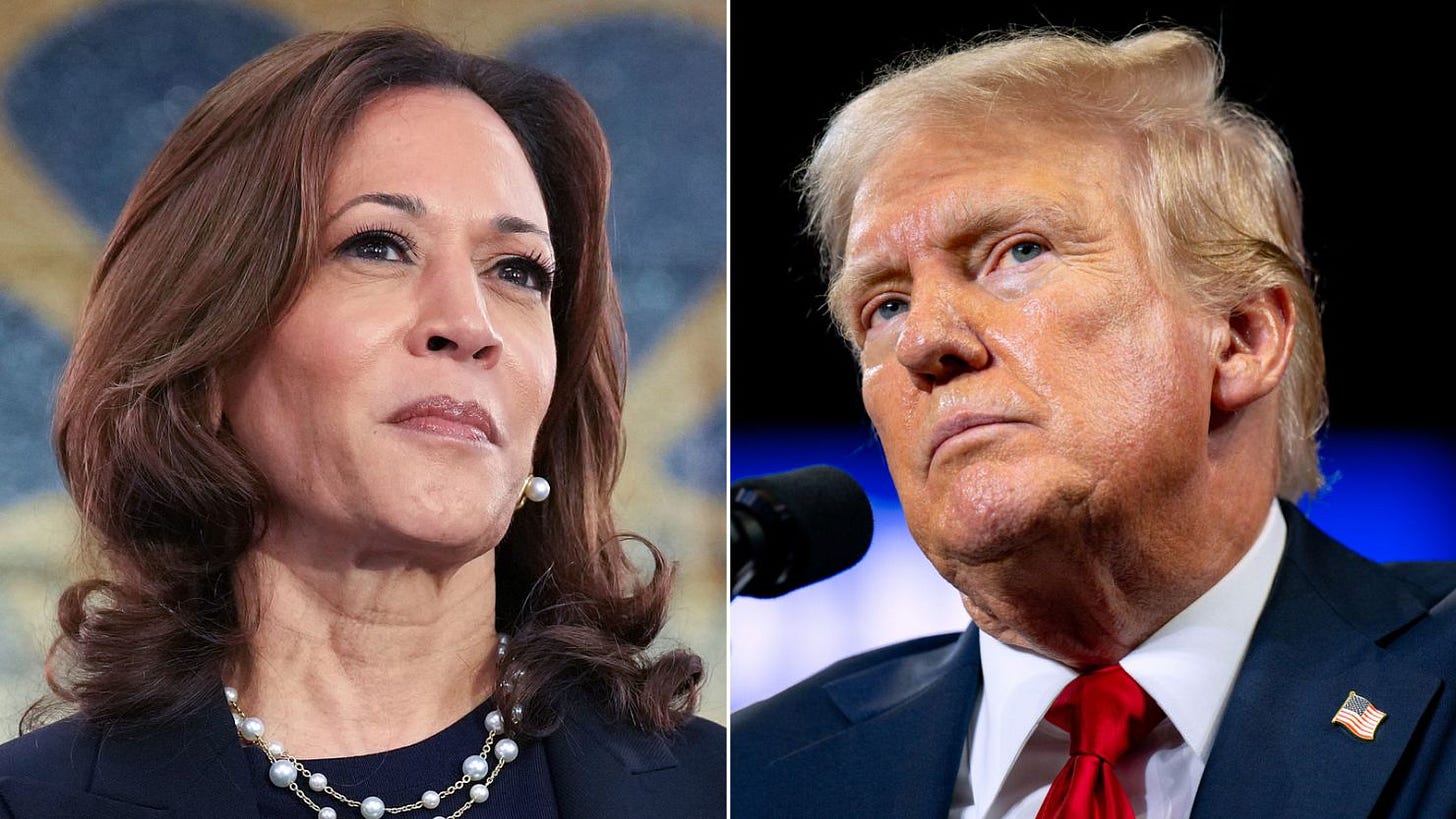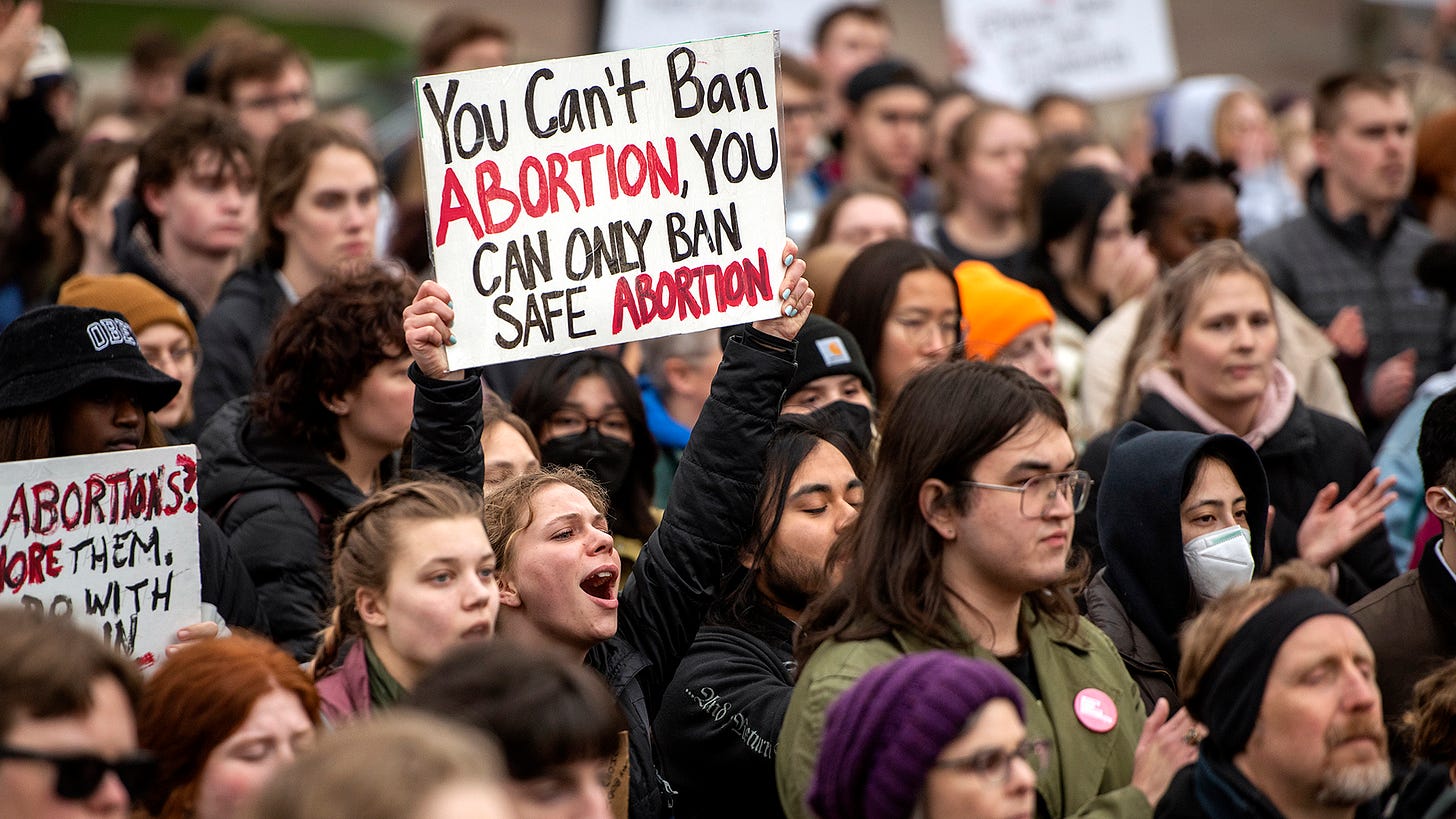Trump v Harris
What the Republican and Democratic party platforms tell us.
“How do we even know what each candidate actually wants to accomplish, and can they do that thing?” That’s the question y’all have been asking me on repeat.
Both parties generally release their platforms during or after their party conventions, so we now have two written policy documents to reference.
What do Harris and Trump actually want to accomplish, and can they do it?
And one thing to note: neither party provides a detailed list of “here is how we will carry out the policy position.” Think of these like the destination sign on the front of the bus: they tell you the general direction in which the bus is heading, the landmarks you might see on your route.
Let’s start with the mottos: For the Republicans: “Make America Great Again!” And for the Democrats: “Forward” or “We Are Not Going Back,” each prominently displayed at Harris rallies.
The Republican platform has 20 stated objectives. They range from “seal the border and stop the migrant invasion” to “build the greatest economy in history,” to, “defeat inflation, and quickly bring down all prices.” You can see all the objectives here.
The Democratic platform is divided into nine parts, with several topics within each part. They range from things like, “Securing our border and fixing the broken immigration system” to “rewarding work, not wealth,” to, “lowering costs.” You can see all the parts here, and one note: this was voted on before Biden stepped aside, so much of it covers Biden’s accomplishments in office and references Biden’s “second term.”
Immigration
Republicans want to begin the “largest deportation program in American history” and say they will “complete the border wall.” They said they will “use all resources” to stop undocumented immigrants from entering the US, including moving federal law enforcement to the border, along with troops currently stationed overseas.
Republicans will also “increase penalties for illegal entry and overstaying Visas.” They say they will reinstate the Remain in Mexico policy which forces migrants seeking asylum in the US to stay in Mexico until their court date with US immigration.
In order to deport migrants, they want to cut federal funding to “sanctuary cities” and prioritize merit-based immigration (which is a system that determines whether or not someone can immigrate based on how many points they receive. Points are given for things like for education level, language fluency, an existing job offer, etc).
Republicans also said they will increase “strict vetting” to keep “foreign Christian-hating Communists, Marxists, and Socialists out of America. Those who join our country must love our Country. We will use extreme vetting to ensure that jihadists and jihadist sympathizers are not admitted.”
Democrats said their goal is to secure the border and fix “the broken immigration system.” They said they will “push Congress to provide the resources and authorities that we need to secure the border. This includes additional border patrol agents, immigration judges, asylum officers, cutting-edge inspection machines to help detect and stop the flow of fentanyl, and funding for cities and states that are sheltering migrants.”
They want to expand legal immigration by hastening the asylum process, allowing families who come together to stay together, streamline the work authorization process to allow immigrants to quickly be allowed to legally work, and secure funding for the DACA program (DACA temporarily stops the deportation of people without documentation who came here as minors).
Democrats said they want to limit the flow of illegal border crossings, and would increase the number of agents at the border. They also said, “When the system is overwhelmed, the President should have emergency authority to expel migrants who are crossing unlawfully and stop processing asylum claims except for those using a safe and orderly process at Ports of Entry.”
Can they do it?
Republicans: can they legally carry out mass deportations? Potentially, yes. The president controls the executive branch of government. But how would they go about deporting potentially tens of millions of people? Reporters have pressed JD Vance for specifics, and he said they would start with “low hanging fruit.”
The logistics of this remain quite nebulous – it would require very significant manpower to carry out. This also has another challenge, in that economists say it will raise costs for consumers, because it will greatly impact the labor market and the cost of labor, which will raise prices.
Many of the other proposals are partially possible without Congress, but the border wall is one that cannot happen without Congress acting – it is very expensive, and without appropriations from Congress, this is not something a president can promise will get done.
Democrats: Nearly all of the proposals require the cooperation of Congress, and many of these were in the recent bipartisan bill that was negotiated by both parties but sunk by Donald Trump and didn’t pass. (This is not my opinion, this is what both Republicans and Democrats in Congress say happened, and many Republicans were angry about it, saying it killed their chances of getting reelected, because they didn’t have a strong record of action to run on.) If Trump is no longer running for office, the border security bill has a much better chance of passing, and changes to asylum laws and border closures could be implemented.
Inflation and costs
The Republicans say they can “defeat inflation” through deregulation (removing or reducing government restrictions.)
The RNC platform says it will “unleash American energy” by increasing oil and natural gas production and ending the “Socialist Green New Deal.” (The Green New Deal is a series of plans that address climate change, job creation, and environmental issues.)
Republicans say they will “stabilize the Economy by slashing wasteful Government spending and promoting Economic Growth. They also say that illegal immigration has increased inflation, as well as the cost of housing, education and health care. By stopping immigration, they will reduce inflation.
Democrats say inflation is still too high because during the pandemic, supply chain disruptions forced companies to raise prices. Now that supply chains have been restored and inflation has dropped, some companies “haven’t passed those new savings on to consumers.” (Meaning that according to Democrats, some companies are keeping their prices artificially high.) The platform says the new president will “crack down on price gouging, and get companies to use their record profits to reduce prices long-term.”
In their platform, the Democrats say they will invest in making more things in the US, which will boost supply, bring prices down, and add more jobs. They also say they will require drug companies that “raise prices faster than inflation” to pay back the extra cost to Medicare.
Can they do it?
Republicans: The government does not produce oil and gas, and American oil and gas production is largely controlled by the market forces of supply and demand. In 2023, the US produced more crude oil than any country, ever, so it’s unclear how we could increase oil production and what this would do to inflation.
“Reducing government spending” is something largely controlled by Congress. And while the executive branch does have a lot of control over executive departments like Customs and Border Protection, without Congress, they can’t hire new agents or enact new programs to direct more resources toward immigration. The consensus view from economists is that immigration has a modest effect on lowering inflation, not increasing it.
Democrats:It is possible to use federal rule making abilities to create anti-price gouging rules, but it’s unclear how effective those will be at reducing costs. Much of this will be dependent on the specific rules. Investing in making more things in the US will also require the approval of Congress, as it usually includes tax incentives or grants that a president cannot enact on their own.
Abortion
The word abortion only appears only one time in the 28-page Republican platform document.
Here’s the full section: “We proudly stand for families and Life. We believe that the 14th Amendment to the Constitution of the United States guarantees that no person can be denied Life or Liberty without Due Process, and that the States are, therefore, free to pass Laws protecting those Rights. After 51 years, because of us, that power has been given to the States and to a vote of the People. We will oppose Late Term Abortion, while supporting mothers and policies that advance Prenatal Care, access to Birth Control, and IVF (fertility treatments).”
Democrats use the word abortion 13 times. They want to pass national legislation protecting the right to abortion. They also want to strengthen access to FDA-approved medication abortions, birth control, protect access to fertility treatments, and repeal the Hyde Amendment (which blocks abortion coverage for people enrolled in Medicaid and Medicare).
They also say they will defend access to “emergency medical care” which preempts abortion bans, and will challenge “threats from Republicans to prosecute people who help women travel to a different state for abortion care.”
Can they do it?
Republicans: this is largely already done, although Republicans did block a bill that would have given federal protection to IVF access. I don’t know what kind of specifics they are referring to when they say they want to promote access to prenatal care and birth control, that is the entirety of their statement, so I cannot assess this aspect of the platform.
Democrats: All of these things are very difficult to change without Congress. They say they want to pass legislation to protect abortion, but… say it with me…only Congress has this power. Would Harris sign the legislation? Most assuredly yes.
There is so much more to talk about, I had to move most of their economic plans to another article. Was this helpful? Should I share more about their platforms?
The Preamble is reader supported. If you find our work helpful, please consider becoming a paid subscriber.







I would love to see an infographic akin to a "fact check" of all statements made in these plans, side by side, with a "what it would take to actually accomplish this" blurb for each (similar to what you've done here). Politicians are great at saying all the things, but coming from someone who's worked in government it is *never* that easy/straightforward and I feel the general public gets misled with the broad statements both sides routinely make.
Thank you! Understanding what a President can and can’t do is so important.
I find the short section on abortion in the Republican platform interesting. I think it shows a clear understanding that going hard against abortion federally is going to tank their chances of winning. I’m really curious if stepping back will help or hurt.
Regardless of who wins, this just shows that we need a Congress that functions. Not much can happen if they refuse to work together.
My community is currently dealing with the aftermath of flooding from Debby. FEMA is almost out of money and Congress is on vacation instead of making sure our country is funded because they can’t come to an agreement.